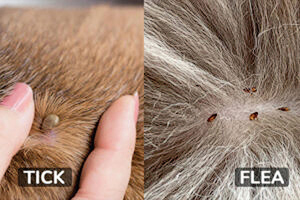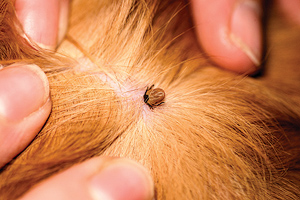Desert environments offer a unique set of challenges when it comes to pet care, especially when it comes to fleas and ticks. While the dry, hot conditions may seem inhospitable for these pesky parasites, fleas and ticks have adapted to survive in desert climates, and they can still pose significant threats to your pets. This extremely mild winter that Moab has experienced means we are in for a rough flea and tick season.
 Understanding Fleas and Ticks in the Desert Understanding Fleas and Ticks in the Desert
Fleas and ticks are parasitic organisms that rely on animals (including pets) for blood meals. While they are commonly associated with wetter, more temperate climates, these pests are quite capable of surviving in arid desert regions. Understanding how these parasites adapt to the desert and the challenges they present to your pet is crucial for effective prevention and care.
Fleas are small, wingless insects that thrive in environments with high humidity and moderate temperatures. While the dry desert climate may not seem like an ideal habitat, fleas can survive by finding sheltered areas, such as under bushes, in shaded corners, or inside homes. Flea larvae are highly sensitive to temperature and humidity but can survive in shaded areas or indoor environments where these conditions are more favorable.
Pets living in desert regions may still come into contact with fleas, particularly if they interact with other animals (strays, wildlife, or other pets) or visit places where fleas can thrive, such as parks, shaded outdoor areas, or even your home. Fleas can cause skin irritation, itching, and allergic reactions, and they can also transmit diseases like tapeworms.
Ticks are hardy arachnids that are capable of surviving in dry conditions, including deserts. Unlike fleas, ticks don't live on pets permanently; instead, they latch onto animals when they pass by, attaching themselves to the skin to feed on blood. While ticks are often associated with humid environments, many species are well-suited to the desert climate. Some ticks, such as the brown dog tick, are commonly found in desert regions and can infest your pets if they venture into areas like tall grasses, bushes, or wooded regions.
Ticks are particularly dangerous because they can carry a wide range of serious diseases, including Lyme disease, Rocky Mountain spotted fever, and ehrlichiosis. In desert regions, ticks can be found in areas where pets roam, especially during the cooler times of the year when wildlife and pets are more active.
The Importance of Flea and Tick Prevention for Pets
Flea and tick infestations can lead to a variety of health problems for pets. Fleas can cause intense itching, hair loss, and allergic reactions, while ticks can transmit potentially deadly diseases. The impact of these pests is not just physical—infestations can lead to increased stress for both pets and owners. In the desert, where temperatures can soar during the day and dip at night, pets are at an increased risk of dehydration and heatstroke if they become overly stressed from flea and tick bites. Effective flea and tick prevention is essential for the well-being of your pets. By taking proactive measures, you can avoid the hassle of dealing with infestations and the potential health risks these pests pose.
Flea and Tick Prevention Tips for Desert-Dwelling Pets
Use Year-Round Flea and Tick Protection, especially when winters have been mild.
In desert environments, it's important to use flea and tick prevention treatments year-round. While the risk is greatly reduced during the winter in Moab, with the amount of visitors coming from areas that are high risk all year long we encounter a greater risk for local pets. In the desert, temperature fluctuations and seasonal rains can also provide the conditions necessary for flea and tick survival, and this year the warm winter temperatures will provide better conditions for pest survival.
 There are several options available for year-round prevention, including: There are several options available for year-round prevention, including:
Topical Treatments: These are applied directly to the pet’s skin, usually at the base of the neck. These treatments are highly effective in killing fleas and ticks and preventing future infestations.
Oral Medications: Oral flea and tick preventatives are ingested by the pet, and they work by killing fleas and ticks when they bite. These products are highly effective and offer the added benefit of not requiring application to the skin, making them less likely to be rubbed off.
Flea Collars: Specialized collars can provide long-lasting protection against both fleas and ticks. These collars work by releasing chemicals that kill and repel pests over several months.
Shampoos and Sprays: Flea and tick shampoos are available for a quick, on-the-spot solution. While they don't provide long-lasting protection, they can be a good option if you're dealing with a current infestation.
Regularly Inspect Your Pet for Fleas and Ticks
Even with preventive treatments, it’s important to regularly check your pet for fleas and ticks, especially if your pet spends time outdoors. Ticks are often easy to overlook since they attach to the skin and can be small at first, but a thorough inspection can help you catch them early before they have a chance to cause serious harm.
When checking your pet, focus on areas where ticks are most likely to attach, such as:
• Under the ears
• Around the eyes
• Between the toes
• Under the collar
• On the belly and armpits
Fleas can be harder to spot, but you may notice your pet scratching or biting excessively. You can also use a flea comb to check for adult fleas and flea dirt (which looks like small black specks) in your pet’s fur.
Control Your Pet's Environment
One of the best ways to prevent flea and tick infestations is to manage your pet's environment. This includes not only where your pet roams outdoors but also how you care for your home and yard.
Outdoor Care: Avoid taking your pet to areas where fleas and ticks are more likely to thrive, such as tall grasses, dense brush, or areas with wildlife. If you live in an area where ticks are common, try to limit walks to paved paths or well-maintained areas.
Indoor Care: Fleas are often brought inside by pets, so keeping your home clean is crucial. Vacuum regularly, especially in areas where your pet spends the most time. Wash your pet’s bedding and toys frequently to remove fleas and their eggs.
Yard Maintenance: Keep your yard well-maintained by trimming grass, removing brush piles, and controlling weeds. These areas can provide a haven for fleas, ticks, and other pests.
Manage Your Pet’s Health
A healthy pet is better equipped to deal with the stress and irritation caused by fleas and ticks. Make sure your pet is up-to-date on vaccinations and receives regular vet check-ups to ensure overall health. Additionally, provide your pet with a high quality balanced diet and plenty of fresh water to help boost their immune system and keep them strong against infestations.
Be Aware of Desert Wildlife
Desert wildlife, including rodents and larger mammals, can be hosts for fleas and ticks. Wildlife can carry fleas and ticks into your pet’s environment, even if your pet doesn’t directly interact with them. Be mindful of the wildlife in your area, and ensure that your pet avoids contact with animals that could potentially transmit these pests.
Flea and tick care for pets in the desert requires a comprehensive approach that includes prevention, regular monitoring, and environmental management. By staying vigilant and using the right preventive measures, you can keep your pets safe from these harmful parasites. The key is to be proactive and prepared, ensuring your pet remains happy, healthy, and protected from fleas and ticks throughout the year.
|